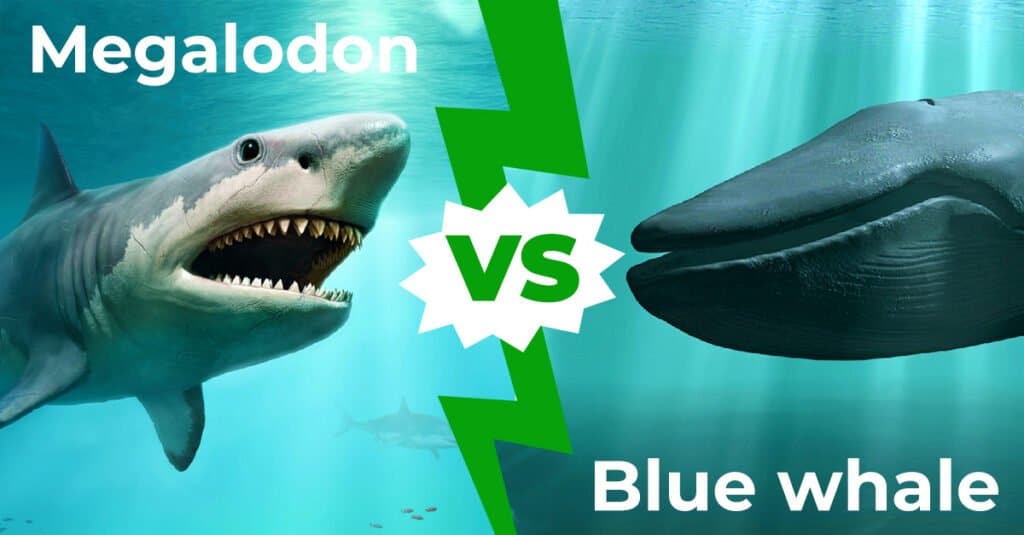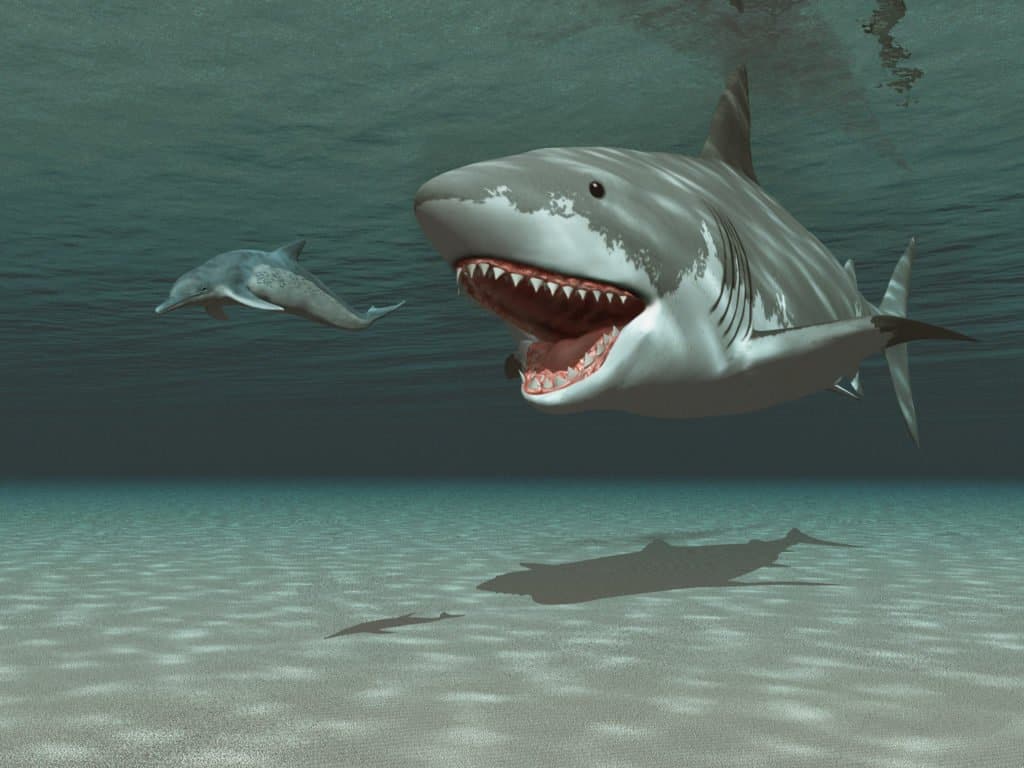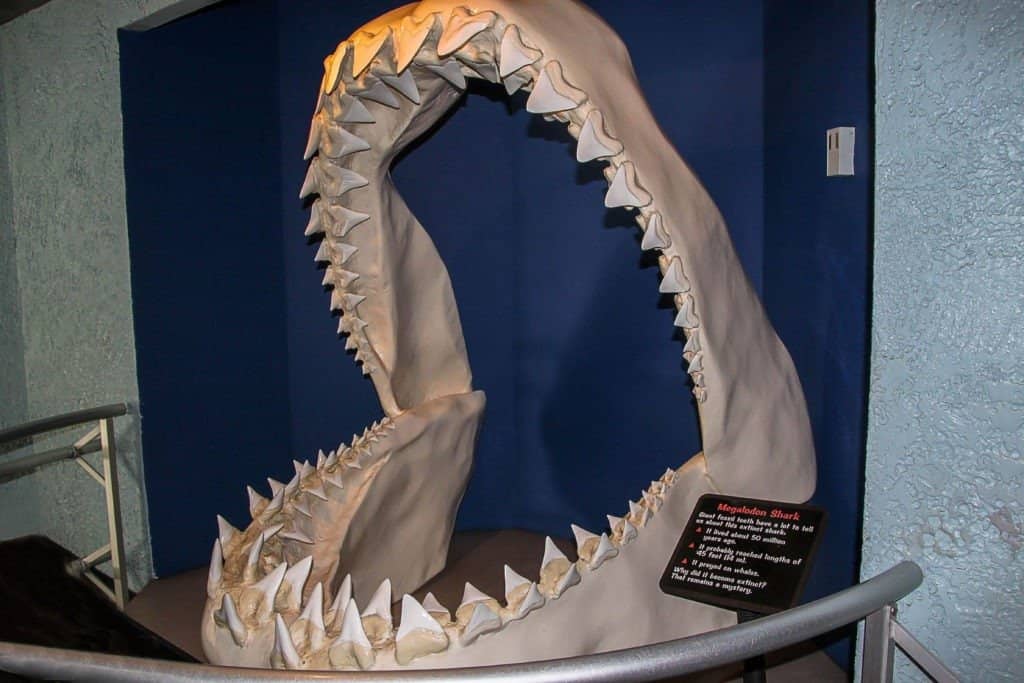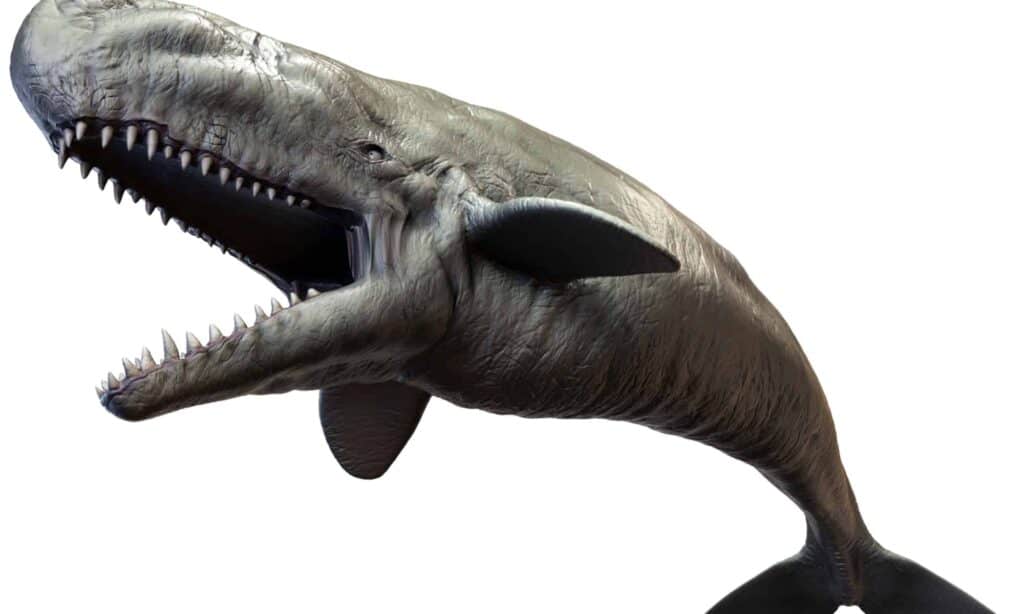A megalodon vs blue whale matchup is very interesting on paper, but these creatures have a few million years separating them from one another. That might be for the best.
The megalodon was a massive shark that went extinct over 3 million years ago, but we do not know why. The fossil records indicate that the megalodon was an apex predator. By looking at the evidence of this creature’s existence, including possible descendants around today, scientists can fathom the deadly potential of this creature.
The blue whale is probably the largest creature that has ever lived, and it is certainly the largest creature alive today. Does that mean it could take down a megalodon?
To get to the bottom of this question, we’re going to look at the available evidence including the physical and mental characteristics of these creatures to see how they measure up. Then, we are going to imagine that a megalodon and a blue whale meet and decide that the ocean is not big enough for both of them.
Comparing a Megalodon vs Blue Whale

| Megalodon | Blue Whale | |
| Size | Weight: 50 tons Length: upwards of 67 feet | Weight: 100-110 tons Length: upwards of 100 feet |
| Speed and Movement Type | – 11 mph -Undulating, side-to-side motions of body and tail are used for propulsion | -5 mph and up to 20 mph for short times -Move tail up and down for propulsion and fins to steer |
| Bite Power and Teeth | –41,000lbf bite power -250 teeth in 5 rows Roughly 7-inch teeth | – Devoid of biting power; have baleen instead of teeth. |
| Senses | -Highly attuned sense of smell -Great vision, especially in low-light settings -Hearing is strong enough to hear splashing prey –Ampullae of Lorenzini helped detect living creatures. | -Poor or absent sense of smell -Can see 35 feet in the water -Acute hearing: they can hear at very low frequencies and call other whales from miles away |
| Defenses | -Massive size -Speed | -Vast body size -Swim speed -A thick protective layer of blubber |
| Offensive Capabilities | -Jaws exceeding 6.5 feet in diameter -250 teeth, about 7-inches long each -High swim speed | -Tail thrashing |
| Predatory Behavior | -Stealth predator that ambushed prey | -Skim feeding or lunge feeding |
The Key Factors in a Megalodon vs Blue Whale Fight

The size, weight, and offensive capabilities would play a role in this fight.
©Esteban De Armas/Shutterstock.com
The Key Differences Between Megalodon and a Blue Whale
There are several differences between blue whales and megalodons. First of all, blue whales are significantly larger than megalodons. The largest blue whale ever weighed 418,878 pounds (more than 200 tons) while average blue whales weigh more than 100 tons. In addition, megalodons were sexually dimorphic, which means the females were significantly larger than males.
Second, blue whales are peaceful filter-feeding omnivores, but megalodons were carnivores back when they roamed the ocean. Blue whales feed on massive amounts of tiny animals like krill while megalodons were apex predators.
Additionally, these massive creatures have very different backgrounds. The megalodon is related to the modern-day shark, while the blue whale is a baleen whale, a mammal. During the time that megalodon lived, it fed on more mid-sized whales and no whales the size of blue whales or other modern baleen giants existed.
Yet, many still can’t help wonder whether a shark the size of a megalodon would be a successful predator against blue whales.
Every fight between two creatures comes down to a handful of factors that decide the outcome. When examining the megalodon and blue whale battle, we are going to look at physical features as well as how they attack and defend against other enemies.
Using these insights, we can determine which creature is most likely to win a battle against the other.
Physical Attributes for Megalodon vs Blue Whale
In many cases, the larger, faster, and better-equipped creatures win battles against each other. Here are the ways that the megalodon and blue whale measure up to one another.
Megalodon vs Blue Whale: Size
The blue whale is the biggest living being alive today and it is far larger than any megalodon. The blue whale can grow upwards of 100 feet long and weighs more than 110 tons. Simply put, this is an absolutely massive mammal that has no equal.
Most estimates of megalodon put an upper length at around 50 feet and 50 tons. Some larger estimates do exist (placing megalodon up to 67 feet in length and well beyond 50 tons), but the fact of the matter is megalodon was smaller than a blue whale.
In terms of size, a blue whale gets the advantage.

Blue whales are larger and heavier than a megalodon.
©Atomic Roderick/Shutterstock.com
Megalodon vs Blue Whale: Speed and Movement
We can only estimate the speed of the megalodon by looking at how similar sharks move today. Based on the best data available, a megalodon would move at about 11 mph in the water, very fast considering its size. They propel themselves with a side-to-side movement of their tails and bodies.
The blue whale cruises along at 5 mph by using its tail in an up and down motion. When it’s trying to lunge and capture a meal or getting away from potential threats, the blue whale can move at a dizzying 20 mph.
The blue whale can outpace the megalodon, and it gets the advantage in speed.
Megalodon vs Blue Whale: Bite Power and Teeth
The blue whale does not have true teeth. They are skim-feeders that use baleen filters to sift through their prey. Thus, they can’t really compete with megalodons.
The truth is that few creatures throughout the world’s history could compete with a megalodon because of their immense biting power. They have 41,000lbf of biting power and 250 teeth that are 6-7 inches in length. They have one of the most powerful bites ever and it’s coming from a highly aggressive species.
The megalodon gets the advantage for biting power and teeth.
Megalodon vs Blue Whale: Senses
The megalodon is believed to have senses that are akin to a great white shark. That means they have an amazing sense of smell that can pick up the scent of prey in the water with ease. Their vision is great over short distances, and it is effective when there is not much light. They also hear very well and have an electrical sensing system in their bodies.
Blue whales cannot compete with them in terms of senses, with only their hearing being above average. Their sight and smell are not very good.
The megalodon gets the advantage in terms of senses, too.
Megalodon vs Blue Whale: Defenses
Blue whales have vast bodies, the type that most predators do not want to try attacking out of fear of what something that large could do to them. That is the whale’s best defense, along with its thick layer of blubber that protects vital areas and their very fast bursts of speed.
Megalodons are large and quick, but their defenses are not that robust.
Blue whales have better physical defenses than megalodons.
Combat Prowess of a Megalodon vs Blue Whale

A megalodon has 250 teeth and their jaws are 6.5 feet in diameter.
©ilikeyellow/Shutterstock.com
Great physical power is helpful, but a fight comes down to experience using one’s body to inflict damage on others. Let’s see how these creatures measure up.
Megalodon vs Blue Whale: Offensive Capabilities
Blue whales have few offensive capabilities against predators. They can use their speed to get away and thrash their tails at other enemies, stunning or killing them if they land a hit.
Megalodons have massive jaws, deadly bites, and honed killing instincts, and they can chase down most prey.
Megalodons have far more in the way of offensive power.
Megalodon vs Blue Whale: Predatory Behavior
When looking for a meal, it’s believed that a megalodon was similar to a great white shark. They would use stealthy ambushes to sneak up on some enemies or simply use their high swimming speed to catch and thrash them.
Blue whales don’t look for trouble often; they are far more likely to be filter-feeding for food.
Megalodons have far better predator behavior.
Who Would Win in a Fight Between Megalodon vs Blue Whale?

A megalodon would win in a fight against a blue whale using it’s powerful bite and speed.
©Mulevich/Shutterstock.com
A megalodon would win a fight against a blue whale for many reasons. For some context, we must consider a recent case where sharks were witnessed chasing down and killing a humpback whale, a creature several times larger than them.
They attacked, inflicted massive wounds, and evaded any possible counterattacks.
That is the likely approach that a megalodon would take for a blue whale, but it would be a great undertaking. The shark would strike first, probably before the blue whale even spotted the creature. It would notice the megalodon’s presence right away, as it takes a massive chunk out of the whale’s side.
From that point on, the megalodon just has to stay away from the blue whale’s tail, take an occasional bite, and wait for the massive creature to get tired. Sure, a blue whale could land a critical and disorienting strike on a megalodon and then run, but in a toe-to-toe fight, they don’t stand a chance.
The more likely case is that the shark gets the first few strikes and follows the trail of blood as the blue whale becomes more and more exhausted before drowning or succumbing to massive blood loss over time.
Either way, the megalodon wins.
Could Anything Defeat the Megalodon?

Livyatan was given the scientific name
L. melvilleiin honor of Herman Melville, the author of Moby Dick.
©Herschel Hoffmeyer/Shutterstock.com
While our oceans may not possess any creature capable of measuring up to the massive megalodon today, millions of years ago the Earth and its seas were full of giants. One colossal predator that regularly contended with the Megalodon in its day was the Livyatan, an ancient relative of the sperm whale. These massive apex predators could grow to be an astonishing 57 feet in length and weigh an incredible 62.8 tons. On top of this, the livyatan was equipped with teeth reaching 1 ft long each that could deal serious damage to a megalodon.
It is believed these whales shared the trait of echolocation with their modern ancestors. This means they would be able to use electromagnetic signals in the water to locate their prey without having to perceive them with their other senses. Megalodons were also adept at using their senses to dominate their environments, but nevertheless, the livyatan had too much mass, speed, and power for the sharks to be able to keep up.
Could a Megalodon Still Live?

If megalodon were alive today, one of the key indicators of its existence would be shark teeth littering the ocean floor.
©Gil Cohiba/Shutterstock.com
Despite what some may have claimed, the megalodon is not alive today. Animals as large as these would not go unnoticed and if they were roaming the oceans, the food chain would look drastically different. There are no current marine mammals alive today that ranked as high on the list of apex predators as this massive shark did.
Based on fossil remains discovered, researchers believe that these mammoth sharks had a lifespan that ranged from 88 to 100 years. As a warm-water species, megalodon was found throughout the world, with the exception of Antarctica, and if still alive, there would be many signs. One of the top indicators would be shark teeth. Sharks tend to lose a tooth a week and megalodons are no exception. Their teeth would still be found littering ocean floors.
Although the exact reason for their extinction is not entirely known, it is believed that one of the key reasons is climate change. As the sea levels were drastically reduced, their habitat was lessoned, and today, the sea levels are still considerably lower than in the Pliocene, when Megalon ruled the oceans.
The photo featured at the top of this post is ©
Thank you for reading! Have some feedback for us? Contact the AZ Animals editorial team.






